| "Cosmos, the endless cycle of live and death." |
 |
|
Lao Tzu in Tao Te Ching |
"The Cosmos for OS/2" was developed by me during the period 1992 and 1995 and further enhanced
in subsequent years. The project very much started as a learning excersize
for the "C" programming language, the OS/2 Operating System and
OS/2 Presentation Manager programming (now available as eComStation). To
have some tangiable results of this learning I started developing a planetarium
application. Cosmos has been available on the market from 1994 and exclusively
distributed by Mensys from 1996 until 2004.
Cosmos was the first so called "edu-tainment" (from educational
and entertainment) application for 32-bit OS/2 Version 2 and did receive
the "IBM OS/2 2.0 Development
Award".
The latest OS/2 Warp video drivers are however not downward compatible
with the official API's that I use these years ago, which means that part
of the program needs te be re-written to get it to work again.
An
undertaking that I do not plan for the near future.
Cosmos had become a program which was designed to aid the astronomical
observer, from the novice to the expert. It offers one of the quickest
and easiest ways to learn about astronomy end get acquainted with the heavens.
The graphics capability
of the personal computer are used to display or simulate star charts which can
include:
- Stars
- Deep-sky Objects (Galaxies, Clusters, Nebulael etc.)
- Planets, Moon, Sun
- Minor planets (asteroids), comets, etc.
- Lines like Constellation and Milky Way boundaries,
the ecliptic, coordinate lines etc.
- Common names, catalogue numbers, Bayer designation
etc.
- Ephemerides of pre-defined or custom
objects
Cosmos can be very useful as an aid in planning observing sessions which
is an important, but often neglected, part of amateur astronomy. For example,
the program can be used to show what objects will be visible, and whether
they will be well placed for observing. Another use might be to determine
if moonlight will interfere with variable star, or deep sky observations.
In the past, such tasks as these often required that data from an almanac
be plotted by hand on a chart from one of the popular star atlases. Now
a simpler method is available by using Cosmos to generate the desired display.
Cosmos is also helpful in locating and identifying faint objects, in learning
star fields, and as an aid in visualizing what may be seen through the
telescope. In addition, to such practical uses, Cosmos provides an opportunity
for anyone to learn about astronomy and celestial mechanics by graphically
illustrating many of the changes which occur in the sky and by being an
on-line, comprehensive and easily accessible Encyclopedia of Astronomy.

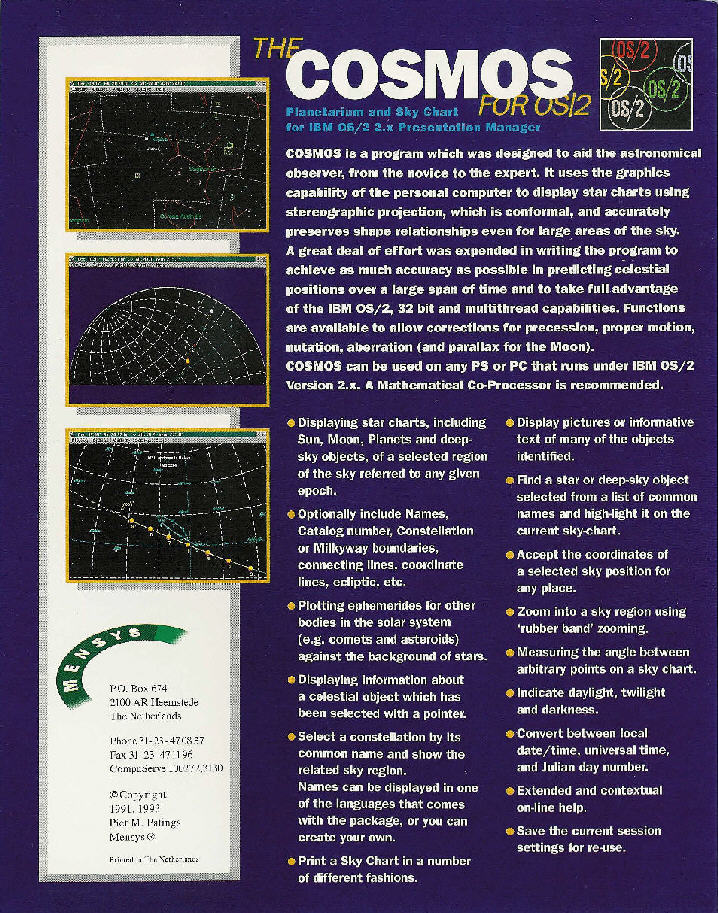
The Cosmos has many features, including:
- Displaying star charts of a selected region of the sky referred to any given epoch.
Lots of information may be optionally include like&colon. Names, catalogue number, Constellation or Milkyway boundaries,
connecting lines etc.
- Simulation of the apparent sky motion and ephemeris of Sun, Moon and planets.
- Displaying of stars and optionally other objects.
If the size and/or orientation of the
object are given in the catalogue, the symbol representing it will be scaled to
approximately that size on the display, unless smaller than the minimum allowed
for the symbol and projected under the appropriate position angle.
Note that the shape of the symbol is used to help visually identify the type of object,
only if shape and size data is available it is representative of its actual
shape and size.
- Many pictures and photo's in the form of a bitmap are available.
- A multitude of options to further "customize" the chart are available, such as:
- Multiple star and deep-sky object database selection, both faint and bright limiting magnitude specification, deep-sky object type selection and more.
- Plotting or simulating ephemerides for the Sun, Moon and planets.
- Plotting ephemerides for other bodies in the solar system (i.e. comets
and asteroids) against the background of stars.
- Displaying information about a celestial object
which has been interactively selected with a pointer.
Note: The Sun, Moon and planets will be scaled to approximately the correct angular size if
larger than the minimum size allowed for these symbols.
- Select a constellation by its common name and show the related sky region.
These names can be displayed in one of the national languages that comes
with the package, or you can create your own if it is not.
- Find a star or deep-sky object selected from a list of common names or
catalogue designations and high-light it on the current sky-chart or re-plot
a sky region when not currently visible.
- Display a photograph of some of the objects identified.
- Show informative text of some of the objects identified and constellations.
- Plotting or simulating ephemerides for the Sun, Moon and planets.
- Plotting ephemerides for other bodies in the solar system (i.e. comets and asteroids) against the background of stars.
- Displaying information about a celestial object which has been interactively selected with a pointer.
Note: The Sun, Moon and planets will be scaled to approximately the correct
angular size if larger than the minimum size allowed for these symbols.
- Select a constellation by its common name and show the related sky region.
These names can be displayed in one of the national languages that comes
with the package, or you can create your own if it is not.
- Find a star or deep-sky object selected from a list of common names or
catalogue designations and high-light it on the current sky-chart or re-plot
a sky region when not currently visible.
- Display a photograph of some of the objects identified.
- Show informative text :elink. of some of the objects
identified and constellations.
- Add and show Personal notes to the on-line documentation and for objects,
either Solar system, star or deep-sky object or for a specific Constellation.
- Accept the coordinates of a selected sky position for any place.
- Zoom into a sky region using 'rubber band' zooming.
- Printing a Sky Chart.
- Measuring the angle between arbitrary points on a sky chart.
- Indicate daylight, twilight and darkness.
- Converting between local date and time, universal time (UT), and Julian day number.
- Extended and contextual on-line help.
- Save the current session settings for re-use.
Cosmos uses several techniques to handle larger databases while still maintaining
(well barely) acceptable speed also for those not blessed with a mathematical
coprocessor.
Because Cosmos takes full advantage of the OS/2 multitasking capabilities
it will also plot in back-ground, hence even without a math-co it will
still be useful; however, use of simulation or large databases should be
avoided. One of the techniques used is breaking the data into several files
containing different magnitude ranges, each sorted by right ascension.
Also, when plotting smaller regions of the sky, efficient search routines
are used to aviod scanning the entire database. Star charts are displayed
using stereographic projection which is conformal, and accurately preserves
shape relationships even for large areas of the sky.
A great deal of effort was expended in
writing the program to achieve as much accuracy as possible in
predicting celestial positions over a large span of time. Functions are
available to allow corrections for precession, proper motion, nutation,
aberration (and parallax for the Moon).
A more detailed description of the algorithms used in Cosmos, and some
estimates of the accuracy which can be expected will be added later here.
The COSMOS for OS/2 Version 4.0 Press release, 19 March 1995
"The COSMOS for OS/2" Version 4.0 is a versatile program in the
category "edutainment". It is not only the first but also the
only one of its kind available for OS/2. Integrating many features not
often found in a single program, this is more than just a desktop planetarium.
Whether you are just intrigued by the richness of the night sky, are an
armchair astronomer, or an experienced observer wanting to plan and record
your observations, this program will appeal to you. COSMOS is a program
which was designed to aid the astronomical observer, from the novice to
the expert. It offers one of the quickest and easiest ways to learn about
astronomy and get acquainted with the heavens even without a real telescope
and clear skies.
The program fully exploits the graphics capability of the personal computer
and the OS/2 80-bit ANSI precision and multithreading capabilities to accurately
display and print star charts, simulate celestial events such as conjunctions
(groupings of planets), occultations (events that occur when the Moon passes
in front of a star) or eclipses (Moon obscuring the Sun), or zoom into
or out from a sky region, with or without animation, at Warp speed.
Star charts are displayed using stereographic projection which is conformal,
and accurately preserves shape relationships even for large areas of the
sky. A great deal of effort was expended in writing the program to achieve
as much accuracy as possible in predicting celestial positions over a large
span of time while preserving performance.
The program comes with the Yale Catalogue of Bright Stars which includes
9,091 stars brighter than magnitude 6.5, a deep-sky catalogue containing
8,414 entries with all 110 Messier objects, Index Catalogue (IC) objects
and New General Catalogue (NGC) objects, and an additional deep-sky database
containing 1,953 entries with a variety of deep-sky object types, including
Dark Nebulae and the recently discovered Dwingeloo-1 galaxy.
Optionally a binary version of the Smithsonian
Astrophysical Observatory catalogue (SAO) can be purchased
which contains
accurate positions of 258,997 stars as faint as magnitude 11.9.
With a click of the mouse information about every object can be accessed
instantly. Not only can you add your own notes and photo's for each and
every one of these, but also for many objects you will find informative
text and 256-color images. Those interested in history, mythology or astrology
will like the Constellation dialog.
Select one of the 88 constellations from a list and read about its history,
add your own notes, plot the related sky region for today, tomorrow or
for the actual day and year of your birth.
See the planets move along the ecliptic relative to the constellation and
see the zodiacal constellations move through the sky throughout the year.
Chose the controls you want, standard Common User Access, a Toolbar or
hide them all to take advantage of the full screen size. Functions are
available to allow corrections for precession (the slow wobble of Earth's
axis over 26,000 years), proper motion, nutation, aberration (and parallax
for the Moon). Find the position of a planet now, 2,000 years ago or 2,000
years in the future, look at the distribution of stars, galaxies, clusters
or nebulae, simulate the motions of planets through the sky, show the positions
of asteroids (minor-planets) or see the rapidly changing orbit of a comet.
Of course you can also add your own objects and let COSMOS take care of
the calculations and projection.
A multitude of options is available to customize the charts to your specific
needs: planets, moon phases, stars, deep-sky objects (galaxies, all types
of nebulae and clusters, star-systems, quasars), labels, lines, numbers,
color (including B-V index), orientation, size, shape, scale, daylight/twilight,
and more. The program even shows the size, shape and orientation of a galaxy
and other deep-sky objects if the information is available in the database.
The fully integrated on-line help uses the OS/2 Help Manager and includes
a "Quick start" option. It provides a convenient way to get acquainted
with the basic concepts of visual astronomy, OS/2-Information Presentation
Facility and the COSMOS program by means of hypertext, hypergraphics and
a comprehensive and easily accessible Encyclopedia of Astronomy in which
all astronomy related terminology, used in the program or on-line help,
is explained. It even lets you add your own notes to the help sections.
The index section contains over 1,300 entries.
COSMOS runs on any machine capable of running OS/2 2.0 or higher. Although
it can run without one, a mathematical co-processor is highly recommended.
Free hard disk space required is 5 Mb with an additional 4.2 Mb if the
SAO database is to be installed (not included).
The "COSMOS for OS/2" Version 4.0 comes on 3 1/2" diskettes.
Version 4.0 retail price: USD 89.95
Upgrade from 3.0: USD 39.95
SAO Database: USD 15.00 Prices may change without notice and exclude
shipping).
Order Information (note that this is no longer valid !):
Worldwide: Mensys Netherlands
Call: +31-(0)23-47 08 37 (after
10/10/95: +31-(0)23-5 47 08 37)
Fax: +31-(0)23-47 11 96 (after 10/10/95:
+31-(0)23-5 47 11 96)
Email: CompuServe: 100272,3130
(from Internet:
100272.3130@compuserve.com)
Mail: Mensys Netherlands
P.O.Box 674, 2100 AR
Heemstede, The Netherlands
Belgium: Mensys Belgium
Call: +32-(0)3-312 46 11, Fax: +32-(0)3-312 47 51
Email: CompuServe: 75103,3217
(from
Internet: 75103.3217@compuserve.com)
Mail: Mensys Belgium
Oostmallebaan 7,
2980 Zoersel, Belgium
U.S.A: Indelible Blue, Inc.
Call: (919) 878-9700, Fax: (919) 878-7479
Email: Compuserve: 76256,3334
Internet:
bbohac@mercury.interpath.net
Mail:
Indelible Blue, Inc.
3209 Gresham Lake Road, Suite 135
Raleigh, NC 27615 U.S.A. or: P.O.Box 31306, Raleigh, NC, 27622-1306 U.S.A.
Canada:
ICONIX
Call: (416) 252-7103 (Toronto)
1-800-OS2 4 ALL, 1-800-672-4255
Mail: ICONIX
P.O.Box 128, Station E, Etobicoke, ON
M9C 4X9, Canada
End of COSMOS Version
4.0 Press release
Below are some impressions taken from the press in the glorious days:
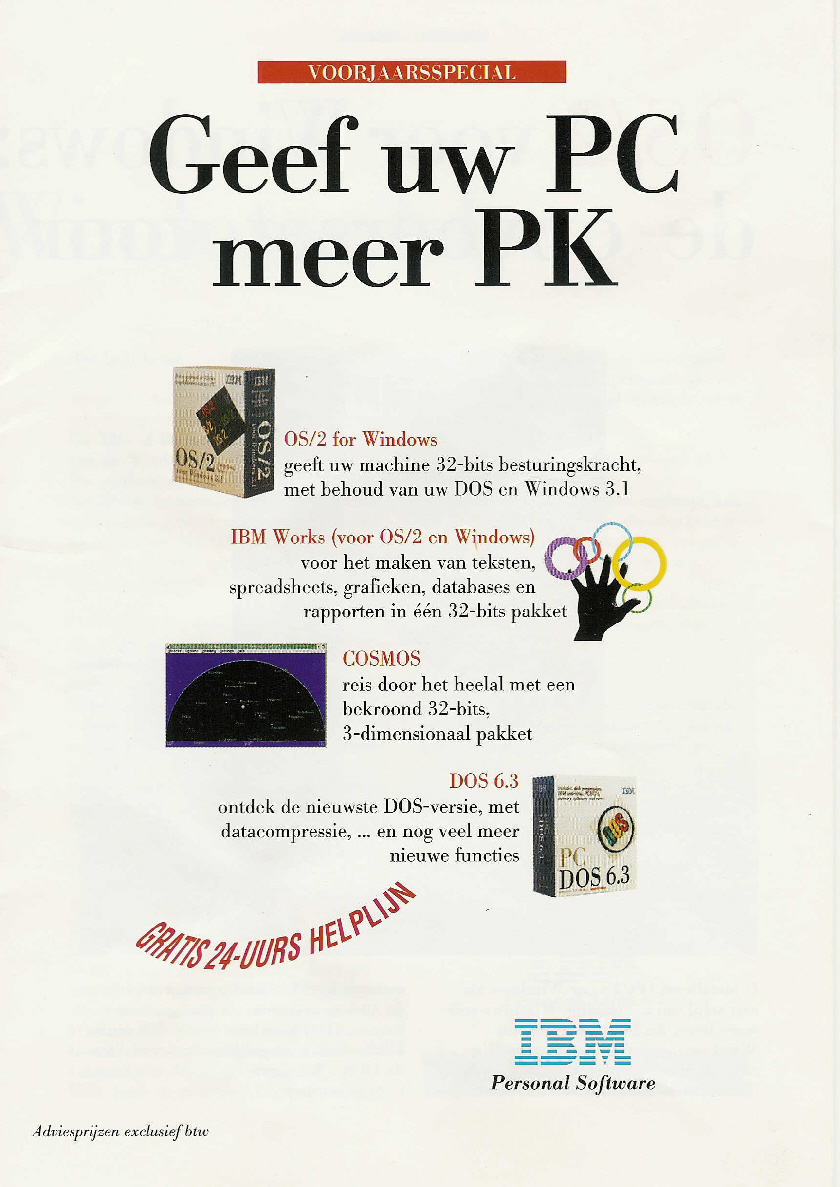
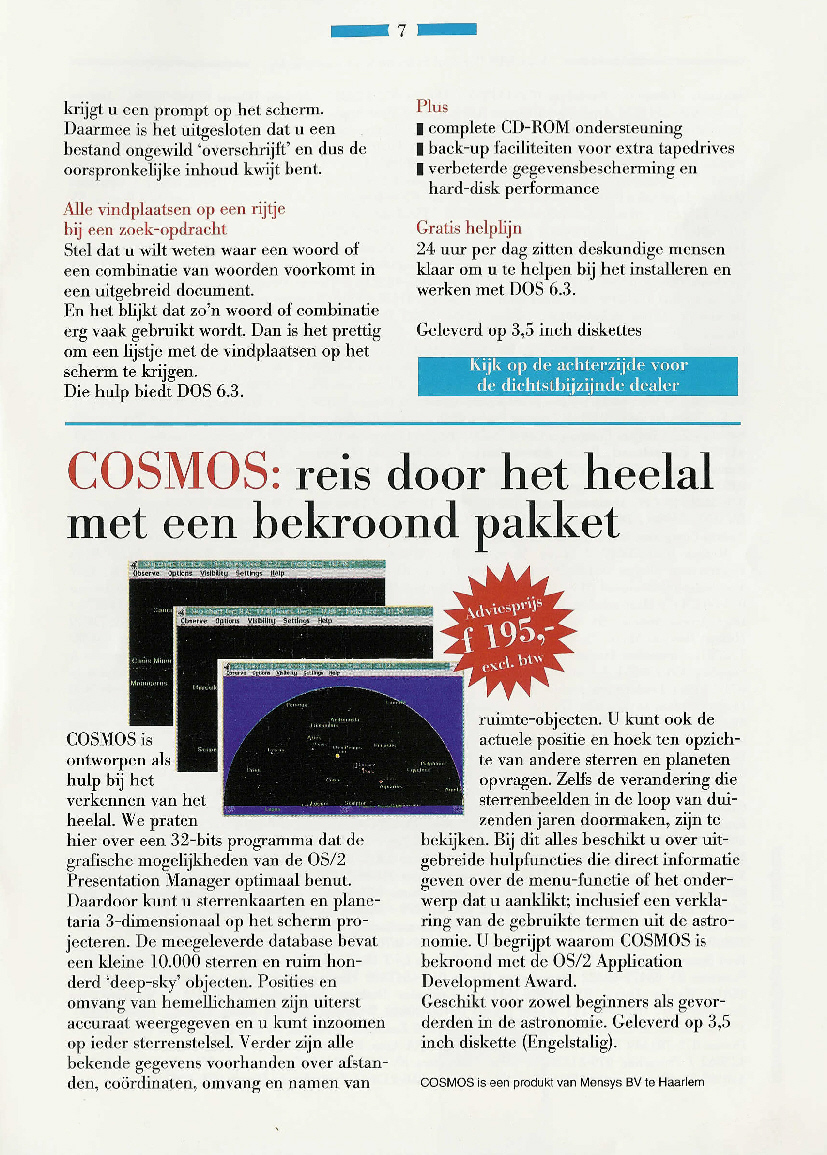
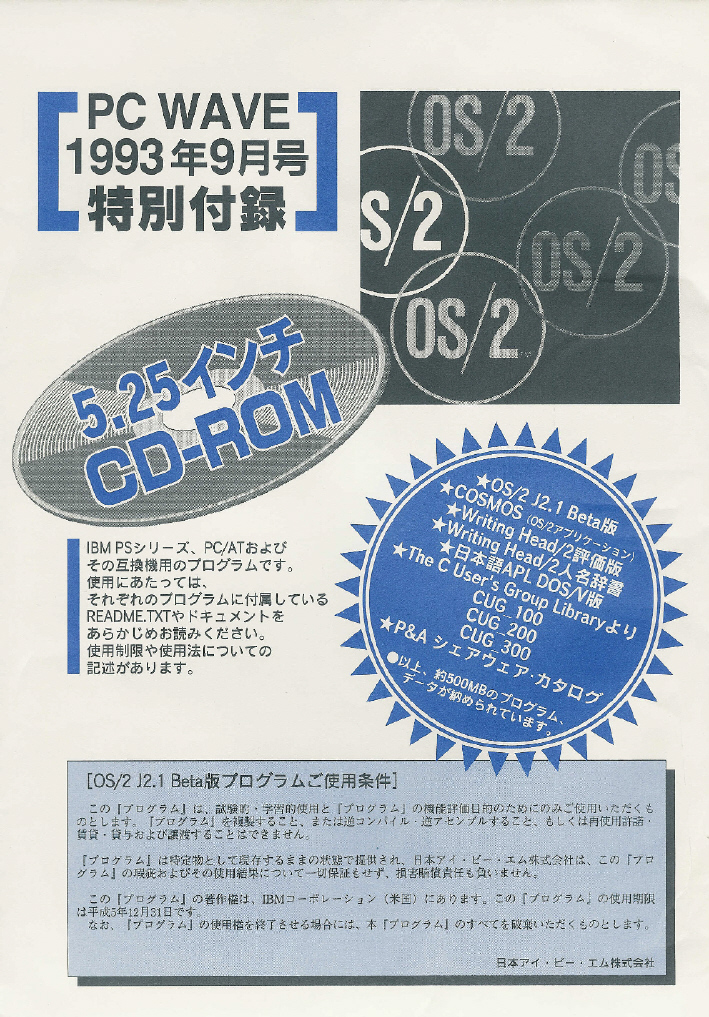
PCW Magazine, December 1993.
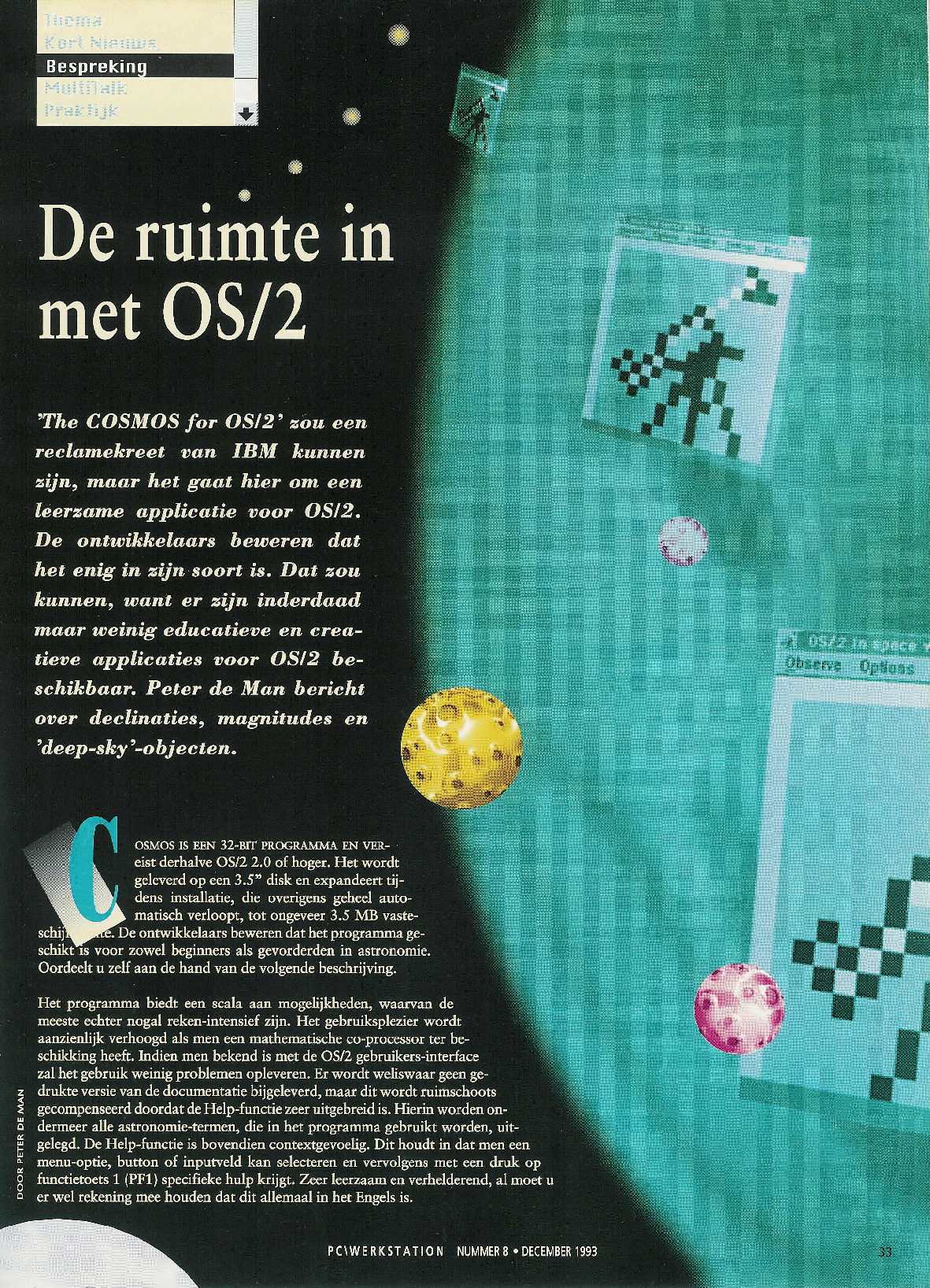






![]()